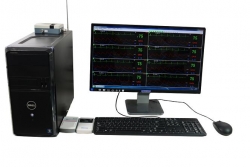Wechat QR code

TEL:400-654-1200

TEL:400-654-1200
Summary of J-wave syndrome
J-point on electrocardiogram refers to the connection point between QRS wave group and ST segment. In some cases (such as low temperature), J-point deviates from the isopotential line and forms J-wave, also known as Osborn wave. A variety of clinical syndromes associated with J wave are called J wave syndrome. Let's recognize these J waves together with pattern recognition in this issue. Mellon
1. Early repolarization syndrome
ECG features: 1) J wave appeared at the junction between the descending branch of R wave and ST segment, especially in the precordial V3-V5 leads; 2) ST segment was shortened and concave upward at J point or after J wave, and arch-back-down elevated 0.1-0.6 mV; 3) T wave elevated leads increased symmetrically in ST segment, and T wave elevated branches often fused with shortened ST segment; 4) R wave elevated in precordial leads could be mistaken for left ventricular high voltage or hypertrophy; The electrocardiographic manifestations of T-segment elevation accompanied by J-point or J-wave can remain unchanged for several years or change significantly in a relatively short period of time. The heart rate increase after exercise can be reduced or disappeared. Mellon

Most early repolarization syndrome is a benign clinical manifestation, but a few patients with history of recurrent syncope, sudden death, family history of sudden death and abnormal increase of J wave may have malignant ventricular arrhythmia. Mellon
Mellon
2. Brugada syndrome
(1) ECG manifestations:
The basic changes are J-point elevation in V1-V3 leads, ST-segment elevation (all (> 0.2mV), T-wave inversion, bidirectional or positive (Brugada wave), and P-R interval can be prolonged with changes similar to right bundle branch block.
(2) Recommendations for diagnostic criteria:
(1) The diagnosis of Brugada syndrome type I can be considered in accordance with the following ECG characteristics: right thoracic leads located between the 2nd, 3rd or 4th ribs, at least one ST segment elevation of type I was recorded spontaneously or induced by class I antiarrhythmic drugs (>0.2mV).
(2) The diagnosis of Brugada syndrome type I I or I I I can be considered in accordance with the following ECG characteristics: right thoracic leads located between the 2nd, 3rd or 4th ribs, at least one ST segment elevation of type I I or I I I can be recorded, and type I ST segment elevation can be induced by class I antiarrhythmic drug provocation test.
(3) Clinical diagnosis of Brugada syndrome: In addition to electrocardiographic features, family history of ventricular fibrillation or polymorphic ventricular tachycardia or sudden death should be recorded.
ECG Recorded at Different Time in the Same Brugada Syndrome
(3) Differentiation between early repolarization syndrome and Brugada syndrome
Early repolarization syndrome: 1) lead of ECG changes: midthoracic lead (V3-V5); 2) J-point: not obvious; 3) J-wave: J-wave and ST-segment division is not obvious; 4) ST-segment morphology: downward oblique elevation (type I).
Brugada syndrome: 1) lead of ECG changes: right thoracic lead (V1-V3); 2) J point: obvious, with setbacks; 3) J wave: J wave: clear demarcation between ST segment; 4) ST segment morphology: concave upward elevation.
3. Cryogenic J-wave
ECG characteristics: 1) regardless of the direction of main wave, J wave is upright (except for aVR lead); 2) the amplitude, duration and lead range of J wave are related to the degree of hypothermia; 3) when hypothermia is accompanied by acidosis, J wave is more likely to appear, and J wave can disappear after PH value transposition is normal due to excessive ventilation; (4) sinus bradycardia, prolonged QT interval, widened QRS wave and blockade are often accompanied; (5) malignant ventricular heart disease. Arrhythmias, including the incidence of ventricular fibrillation, are high; _is related to ventricular rate, J wave can disappear when heart rate increases; _mainly occurs in left thoracic lead, the average vector is left, backward, occasionally forward, revealing that the left anterior part of the left ventricle is more sensitive to hypothermia.
4. High Calcium J Wave
J waves with high calcium content were humped or humped without dome shape, and the QT interval was shortened.
5. Neurogenic J-wave
Central or peripheral nerve disorders can trigger the emergence of electrocardiographic J waves. These diseases include craniocerebral injury, subarachnoid hemorrhage, sympathetic nerve injury during right cervical root surgery, respiratory and cardiac arrest caused by excessive anesthetics and successful resuscitation, brain death, etc.
6. Characteristics of idiopathic J-wave electrocardiogram: 1) QRS wave group can have obvious J wave; 2) Q-wave is more obvious after long intervals; 3) J wave often appears in thoracic leads; 4) other electrocardiographic manifestations of right bundle branch block can occur; (5) prolongation of HV interval in intracardiac electrophysiological examination; (5) analysis with heart rate variability (HRV) as an index shows that HRV value increases during the day, indicating an increase in vagal tension. The decrease of HRV at night reflects the predominance of sympathetic nerve.
7. Ischemic J-wave becomes ischemic J-wave when new J-wave or original J-wave amplitude increases or prolongs in ECG when myocardial ischemia is caused by coronary artery obstruction or functional spasm. ECG characteristics: In acute myocardial ischemia occurring at the same time or later, except for the aVR lead, J wave is upright in other leads. The lead is consistent with or larger than the ischemic site. The duration of J wave is short, and the amplitude changes from high to low or narrow. It is easy to miss diagnosis.